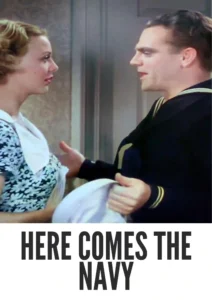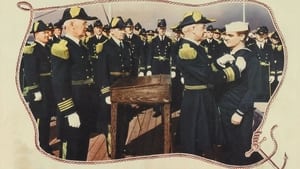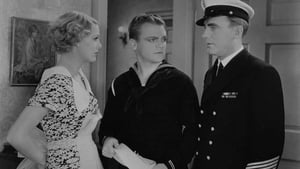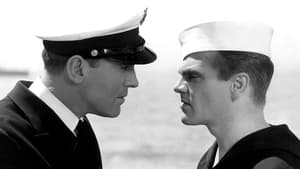Contact: info@alwanfilm.com
Video Sources 0 Views
- Here Comes the Navy 1934 Colorized


Synopsis
Table of Contents
ToggleHere Comes the Navy 1934 Colorized Review: A Romantic Comedy Set Sail in Color

Introduction
In the landscape of pre-war Hollywood cinema, Here Comes the Navy (1934) stands out as a light-hearted romantic comedy that perfectly blends humor, action, and heart. Directed by Lloyd Bacon and starring the legendary James Cagney, this film captures the spirit of adventure, romance, and camaraderie aboard a naval battleship. While the film was originally released in black and white, a subsequent colorized version has reintroduced it to modern audiences, offering a fresh visual perspective on a classic.
This article explores the significance of Here Comes the Navy as one of the earliest films to receive the color treatment, delving into its plot, characters, and themes, and discussing the broader debate about colorizing black-and-white films. We will also analyze how colorization affects the film’s viewing experience and reflect on the lasting influence Here Comes the Navy has had on the genre of romantic comedies and military-themed films.
Check The Full Colorized Movies List
Check Our Colorized Movies Trailer Channel
Understanding Here Comes the Navy 1934 Colorized: Director, Cast, and Genre
Director’s Vision
Lloyd Bacon, the director of Here Comes the Navy (1934), was a master of blending humor with heartfelt drama. Known for his versatility, Bacon seamlessly transitioned from crime dramas to romantic comedies, and in this film, he demonstrated his ability to craft a narrative that was equal parts fun and emotionally engaging. With Here Comes the Navy, Bacon aimed to celebrate the U.S. Navy’s role in national defense while also showcasing the personal stories and relationships that unfold within this unique setting.
Bacon’s vision for the film was to present the Navy in a favorable light, blending patriotic elements with comedic misunderstandings and romance. His direction, coupled with the charm of the cast, created a film that resonated with audiences at the time and continues to do so today.
The Iconic Performance of Actors
The star of Here Comes the Navy is none other than James Cagney, one of Hollywood’s most iconic actors. Cagney portrays Chesty O’Connor, a cocky, hotheaded ironworker who finds himself enlisting in the U.S. Navy to settle a score with a romantic rival. Cagney, known for his tough-guy roles, brings his signature charisma and swagger to the role, but in Here Comes the Navy, he also shows a more comedic and tender side, particularly in his romantic pursuits.
Opposite Cagney is the talented Pat O’Brien, who plays his rival, Biff Martin, a disciplined, rule-abiding naval officer. The dynamic between O’Brien and Cagney is electric, with the two actors engaging in playful banter, heated arguments, and a slowly developing friendship that drives the film’s central tension. Gloria Stuart, best known for her role decades later in Titanic (1997), plays Dorothy Martin, Biff’s sister and Chesty’s love interest. Stuart’s performance as the sweet but independent Dorothy provides the romantic core of the film, offering a counterbalance to the testosterone-fueled antics of Cagney and O’Brien.
Exploring the Genre
Here Comes the Navy (1934) is a romantic comedy at heart, with elements of adventure and military drama woven throughout. The film follows many of the classic conventions of the romantic comedy genre, including a love triangle, misunderstandings, and a reluctant hero who must prove himself worthy of love. However, the film’s setting aboard a battleship during peacetime adds a unique layer of excitement and novelty to the story.
The military aspect of the film provides ample opportunities for action sequences, including drills, training exercises, and a climactic scene that involves Cagney’s character in a daring rescue attempt. The film blends these action-packed moments with lighter comedic scenes, resulting in a film that appeals to a broad audience.
Exploring the World of Here Comes the Navy 1934 Colorized: Plot and Characters
Detailed Synopsis
The film opens with Chesty O’Connor (Cagney), a brash ironworker with a short temper, squaring off against naval officer Biff Martin (O’Brien) during a confrontation at a construction site. Their rivalry intensifies when Chesty discovers that Biff is dating his sister, Dorothy (Stuart). Determined to get even with Biff, Chesty impulsively enlists in the U.S. Navy, believing it will give him a chance to settle the score.
Once aboard the battleship, Chesty’s hotheadedness gets him into constant trouble with his superiors and fellow sailors, particularly Biff, who takes every opportunity to remind Chesty that the Navy is about discipline and teamwork. Despite his rough edges, Chesty quickly proves himself to be a capable sailor, earning the respect of his peers and, eventually, his rival.
As the rivalry between Chesty and Biff plays out on the high seas, a romance blossoms between Chesty and Dorothy. But their relationship faces numerous challenges, particularly when Dorothy’s brother Biff becomes an obstacle. Through a series of misadventures, comedic misunderstandings, and acts of bravery, Chesty must not only prove his love for Dorothy but also his worth as a naval officer.
Memorable Supporting Characters
In addition to the main cast, Here Comes the Navy features a strong ensemble of supporting characters who bring humor and heart to the film. Among them is Frank McHugh as Droopy, Chesty’s best friend and shipmate, who provides comic relief and moral support throughout Chesty’s turbulent journey. McHugh’s natural comedic timing adds levity to the more intense moments of the film.
The film also features a host of naval officers and sailors who contribute to the camaraderie and spirit of the Navy life portrayed in the movie. These characters help create the feeling of a tight-knit community aboard the battleship, adding to the film’s overall sense of adventure and brotherhood.
The Art of Film Colorization
Understanding the Process
Film colorization is a technique that involves adding color to black-and-white films, a process that became more popular in the late 20th century. The goal of colorization is to offer a new visual experience, making older films more appealing to modern audiences. In the case of Here Comes the Navy, the original black-and-white version was later colorized using advanced digital techniques, allowing for a more vibrant and engaging viewing experience.
The process of colorization involves meticulous attention to detail, as each frame must be carefully analyzed and color applied in a way that feels natural and enhances the film’s original aesthetic. For a film like Here Comes the Navy, set largely aboard a naval ship, this means creating accurate color palettes for the uniforms, ship interiors, and the ocean, all while maintaining the overall tone of the film.
Development Over Time
Colorization techniques have come a long way since their inception. Early efforts often produced unnatural or jarring results, but as technology has advanced, so too has the accuracy and quality of colorized films. Today, colorization is done digitally, with artists and technicians using sophisticated software to add color in a way that respects the original composition and lighting of the film.
While the practice of colorizing black-and-white films remains somewhat controversial, there is no denying that it can breathe new life into classic films, making them more visually appealing to modern viewers who may be accustomed to color films.
Early Colored Films: A Brief History
The Emergence of Early Colored Techniques
The journey towards colorized films began in the early 20th century, with filmmakers experimenting with various methods to introduce color into cinema. Early techniques included hand-painting individual film frames or using stencils to apply color to certain parts of a scene. These methods were labor-intensive and often resulted in inconsistent or patchy color, but they represented important steps toward the development of full-color films.
In the 1930s, Technicolor emerged as the dominant process for creating color films, revolutionizing the industry with its vibrant, realistic hues. However, many films, including Here Comes the Navy, were still shot in black and white due to budget constraints or creative choices. The later colorization of films like Here Comes the Navy allowed these classics to be rediscovered by new generations of moviegoers.
Here Comes the Navy and Its Early Colored Version
The Decision to Release in Color
The decision to release a colorized version of Here Comes the Navy was made as part of an effort to bring the film to a broader, more modern audience. By adding color to the original black-and-white film, the creators hoped to enhance its visual appeal and attract viewers who might not otherwise seek out an older film. The colorization process allowed the film to feel more contemporary, while still maintaining the charm and spirit of the original.
Impact on the Visual Narrative
The colorized version of Here Comes the Navy adds a new dimension to the film’s visual narrative. The bright blue of the ocean, the stark white of the sailors’ uniforms, and the metallic sheen of the battleship itself all come to life in ways that were impossible in the original black-and-white version. These enhancements help immerse viewers in the naval setting, making the film feel more dynamic and engaging.
However, as with any colorized film, there is always the risk of losing some of the visual subtleties that black-and-white cinematography can offer. The stark contrasts and careful lighting choices of the original film may be less pronounced in the colorized version, leading some purists to prefer the film in its original format.
The Debate Over Film Colorization
Controversy Surrounding Colorization
The colorization of black-and-white films has long been a topic of debate in the film industry. Critics argue that colorization can undermine the original artistic intent of a film, as directors and cinematographers often chose black and white for specific aesthetic reasons. Additionally, early colorization efforts were often crude and resulted in garish, unrealistic colors that detracted from the film’s overall quality.
However, proponents of colorization argue that it can make classic films more accessible to modern audiences, particularly younger viewers who may be less inclined to watch a black-and-white movie. In the case of Here Comes the Navy, the colorized version has attracted new viewers who may not have otherwise sought out a film from the 1930s.
Examining Here Comes the Navy as an Early Colored Film
How Colorization Enhances the Viewing Experience
In the case of Here Comes the Navy, the colorization enhances the film’s visual appeal, particularly in scenes set aboard the battleship. The navy blue uniforms, the glistening sea, and the action-packed sequences all take on new life in color. The romance between Chesty and Dorothy also benefits from the addition of color, with vibrant tones adding warmth and intimacy to their scenes together.
However, some viewers may argue that the original black-and-white version offers a more authentic representation of the film’s time period and setting. The stark contrasts and shadows of black-and-white cinematography often lend a timeless quality to films from this era, and Here Comes the Navy is no exception.
Influence and Legacy: Here Comes the Navy 1934 Colorized’s Impact on Cinema
Paving the Way for Military-Themed Rom-Coms
Here Comes the Navy (1934) helped pave the way for future films that combined military themes with romantic comedy. Its portrayal of life in the Navy, complete with romantic entanglements and comedic misunderstandings, would inspire subsequent films and television shows set in military environments. The film’s success demonstrated that audiences were hungry for stories that blended action and romance, particularly against the backdrop of a larger, more patriotic narrative.
James Cagney’s Lasting Impact
James Cagney’s performance in Here Comes the Navy further solidified his status as one of Hollywood’s most versatile actors. Known primarily for his tough-guy roles in gangster films, Cagney’s turn as the lovable, hotheaded Chesty O’Connor showcased his ability to handle comedic and romantic material with equal skill. His chemistry with Pat O’Brien, who would go on to co-star with Cagney in several more films, helped create one of the most memorable on-screen duos of the era.
Director’s Cinematic Legacy: Beyond Here Comes the Navy 1934 Colorized
Lloyd Bacon’s Influence on Hollywood
Lloyd Bacon’s contributions to Hollywood extend far beyond Here Comes the Navy. Throughout his prolific career, Bacon directed more than 100 films across a variety of genres, ranging from musicals to crime dramas. His ability to blend humor with heartfelt drama made him one of the most versatile and respected directors of his time. Films like 42nd Street (1933) and Marked Woman (1937) further cemented his legacy as a director who could handle both light and dark subject matter with equal skill.
Themes Explored in Here Comes the Navy 1934 Colorized
Honor, Rivalry, and Redemption
At its core, Here Comes the Navy is a film about honor, rivalry, and redemption. Chesty O’Connor’s journey from brash ironworker to disciplined naval officer is one of personal growth and self-discovery. His rivalry with Biff Martin, initially driven by petty jealousy, evolves into a mutual respect forged through shared experiences and a deepening understanding of what it means to serve in the Navy.
The film also explores themes of loyalty and camaraderie, as Chesty learns to put aside his personal grudges and embrace the values of teamwork and cooperation. These themes resonate not only within the context of the Navy but also in the broader context of life’s challenges and relationships.
Reception and Controversy Surrounding Here Comes the Navy 1934 Colorized
Initial Reviews and Audience Reactions
Upon its release in 1934, Here Comes the Navy received positive reviews from both critics and audiences. James Cagney’s performance was widely praised, as was the film’s lighthearted approach to military life. Audiences appreciated the film’s blend of action, romance, and comedy, and it performed well at the box office.
However, the subsequent colorization of the film sparked some controversy. While the colorized version attracted new viewers, some critics and film purists argued that the addition of color detracted from the film’s original charm and authenticity. Despite this, the colorized version has been embraced by many as a visually appealing alternative to the black-and-white original.
Where to Watch Here Comes the Navy 1934 Colorized Online
For those interested in watching Here Comes the Navy (1934), several streaming platforms offer both the original black-and-white version and the colorized release. The film can be found on popular services like Amazon Prime Video and Turner Classic Movies. Additionally, DVD and Blu-ray versions, including colorized editions, are available for purchase through various retailers.
FAQs About Here Comes the Navy 1934 Colorized
Q: Who starred in Here Comes the Navy (1934)?
A: The film stars James Cagney as Chesty O’Connor, Pat O’Brien as Biff Martin, and Gloria Stuart as Dorothy Martin.
Q: Was Here Comes the Navy filmed in color originally?
A: No, Here Comes the Navy was originally filmed in black and white. The colorized version was created later using modern digital techniques.
Q: What is the central theme of Here Comes the Navy (1934)?
A: The central themes of the film include honor, rivalry, redemption, and the value of teamwork and camaraderie in military life.
Q: Where can I watch Here Comes the Navy (1934)?
A: Here Comes the Navy is available for streaming on platforms like Amazon Prime Video and Turner Classic Movies. DVD and Blu-ray versions are also available.
Conclusion
Here Comes the Navy (1934) is a delightful romantic comedy that combines military action with heartfelt romance and humor. Directed by Lloyd Bacon and featuring a standout performance by James Cagney, the film remains an enduring classic of the 1930s. The later colorized version offers a new way to experience the film, adding visual richness while sparking debate about the merits of colorizing black-and-white classics. Whether enjoyed in its original format or in color, Here Comes the Navy continues to captivate audiences with its timeless story of love, rivalry, and redemption, set against the backdrop of naval life.















